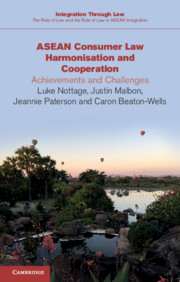Book contents
- ASEAN Consumer Law Harmonisation and Cooperation
- Integration Through Law
- ASEAN Consumer Law Harmonisation and Cooperation
- Copyright page
- Contents
- General editors’ preface
- Figures
- Tables
- Contributors
- Acknowledgements
- Abbreviations
- Chapter 1 Introduction: Backdrop and Overarching Perspectives
- Chapter 2 Theoretical Perspectives on ASEAN and Consumer Law Developments
- Chapter 3 Product Safety Law: Fragmented Regulation and Emergent Product Liability Regimes
- Chapter 4 Regulating Consumer Contracts in ASEAN: Variation and Change
- Chapter 5 Consumer Financial Services: What Role for ASEAN?
- Chapter 6 Professional Health Services: ASEAN’s Trade Liberalisation Agenda
- Chapter 7 Integration with Competition Policies, Laws and Institutions: Opportunities for ASEAN Consumer Protection
- Chapter 8 Key Reflections and Future Directions
- Index
Chapter 3 - Product Safety Law: Fragmented Regulation and Emergent Product Liability Regimes
Published online by Cambridge University Press: 24 August 2019
- ASEAN Consumer Law Harmonisation and Cooperation
- Integration Through Law
- ASEAN Consumer Law Harmonisation and Cooperation
- Copyright page
- Contents
- General editors’ preface
- Figures
- Tables
- Contributors
- Acknowledgements
- Abbreviations
- Chapter 1 Introduction: Backdrop and Overarching Perspectives
- Chapter 2 Theoretical Perspectives on ASEAN and Consumer Law Developments
- Chapter 3 Product Safety Law: Fragmented Regulation and Emergent Product Liability Regimes
- Chapter 4 Regulating Consumer Contracts in ASEAN: Variation and Change
- Chapter 5 Consumer Financial Services: What Role for ASEAN?
- Chapter 6 Professional Health Services: ASEAN’s Trade Liberalisation Agenda
- Chapter 7 Integration with Competition Policies, Laws and Institutions: Opportunities for ASEAN Consumer Protection
- Chapter 8 Key Reflections and Future Directions
- Index
Summary
Consumer product safety law has become a core element of consumer protection law in almost all ASEAN member states. Reforms began by creating post-market intervention powers for consumer affairs regulators, allowing them to ban or recall goods found to be unsafe; and sometimes pre-market powers, to set minimum safety standards. Yet many general consumer affairs regulators still lack capacity and jurisdiction, especially for pre-market powers, limiting capacity to exercise even post-market regulatory powers and to engage in proliferating cross-border standard-setting networks. The Chapter also examines the relationship between regulators and NGOs, as well as with private litigants who may wish to turn instead to the court system to obtain relief for harm from unsafe goods. Five ASEAN states have enacted strict product liability legislation. Indeed, although inspired by 1985 European Union legislation, the versions in Southeast Asia generally are more pro-plaintiff in various ways. Yet there are almost no court filings. Appendices present two extended case studies: informal networks promoting food standards and safety, and formal agreements harmonising cosmetics regulation.
Keywords
- Type
- Chapter
- Information
- ASEAN Consumer Law Harmonisation and CooperationAchievements and Challenges, pp. 122 - 204Publisher: Cambridge University PressPrint publication year: 2019
- 1
- Cited by

